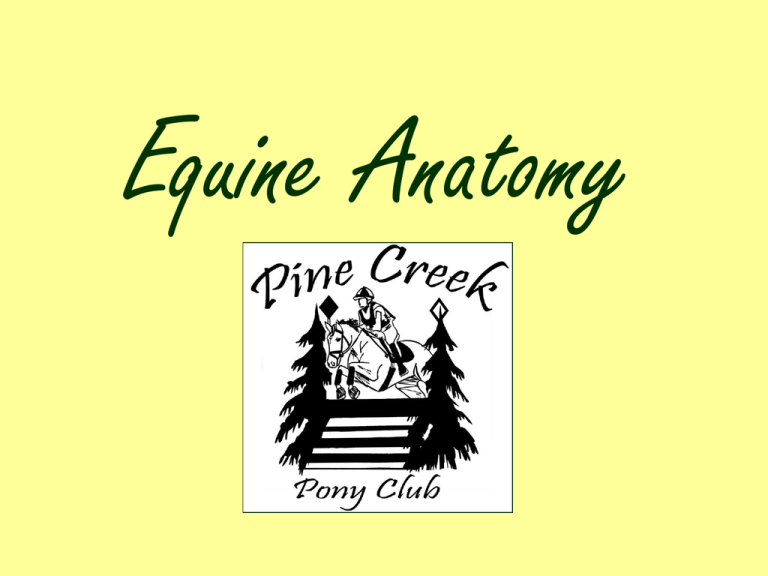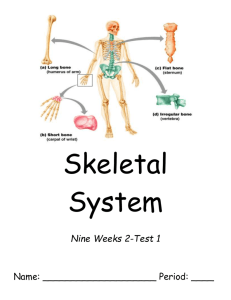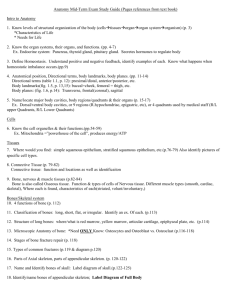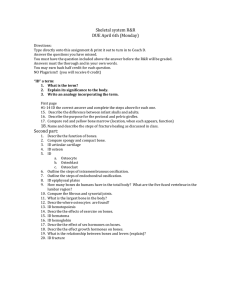Equine Anatomy
advertisement

Equine Anatomy Skeletal and Muscular Systems • Framework of the body • FUNCTION: – Support – Protection of Vital Organs – Movement Joints • • • • Held together by ligaments Provide movement Where the bones meet Some are immoveable, others provide a little movement and others permit a wide range of movement Bones • • • • • • • • Skeleton consists of 206 bones Provide the framework of the body Has levers for movement Attachment points for muscles Protect vital organs They are living tissue with blood vessels and nerves Red blood cells are produced in the marrow Contain protein and minerals (Ca& P) Muscles • • • • Attached to bone by tendons Move the bones Made up of muscle fibers, arranged in bundles Controlled by motor nerves that cause contractions Cartilage • • • • Smooth and firm, but flexible Forms ears and nose Covers articular surfaces of bones in joints Allows bones to move smoothly (Absorbs shock) Tendons • Strong, fibrous connective tissue that connects MUSCLE TO BONE • Tendon sheath protects a tendon containing synovial fluid to lubricate the tendon as it moves Anatomical Planes of Reference • • Left Right • • The animal’s left The animals right • • • Cranial Rostral Caudal • • • Toward the head Toward the tip of the nose (head only) Toward the tail • • Dorsal Ventral • • Toward the back Toward the belly • • Medial Lateral • • Toward the median plane Away from the median plane • • Deep (internal) Superficial (external) • • Toward the center (whole body or part) Toward the surface (whole body or part) • • Proximal Distal • • Toward the body (extremity) Away from the body (extremity) Anatomy of the Carpus • The knee is made of two rows of short bones • These same bones are the ones in a human wrist • The upper row of bones are given names: - Radial carpal bone, ulnar carpal bone, accessory carpal bone, intermediate carpal bone • The lower row of bones are given numbers instead of names - the numbers start inside (medially) working outward (laterally) • http://cal.vet.upenn.edu/projects/mri_edl/anatomy/case1/case1. htm Anatomy of the Metacarpus • Cannon (lg. metacarpal) and splint bones (sm. Metacarpal) • Similar to those in our hands • Horses have a simple foot with only one digit (toe) • The split bones do not support any weight • “Splints” occur from trauma of the ligaments joining the splint and cannon bones together, causing inflammation • http://cal.vet.upenn.edu/projects/mri_edl/anatomy/cas e2/case2.htm Anatomy of the Phalanges • Horses have one digit (toe) on each limb composed of 3 phalanges and 3 sesamoid bones • Named according to their position • Long pastern (1st), short pastern (2nd), coffin bone (3rd) • http://cal.vet.upenn.edu/projects/mri_edl/anato my/case5/case5.htm Anatomy of the Hoof • Coffin Bone: Major bone of the foot, supports the weight of the horse • Navicular Bone: Small wedge-shaped bone lies under the back of the coffin bone • Navicular Bursa: Fluid-filled sac which cushions the navicular bone and deep digital flexor tendon • Deep Digital Flexor Tendon: Crosses the navicular bones and attaches to the underside of the coffin bone Anatomy of the Hoof • Digital Cushion: Spongy structure above the frog • Coronary Band: Outer band of tissue at the hairline, from which the hoof grows • Corium: The deep tissue beneath the coronay band, which provides the horn • Wall: hard outer shell of the hoof • Bars: back of the wall; aid in absorbing shock and allows it to expand under pressure • Sensitive Laminate: lock the wall to interior of hoof, have blood and nerve supply Anatomy of the Hoof • Periople: Outer layer of the hoof- keeps moisture in • Sole: Ground surface of the hoof, inside the wall • Frog: Wedge-shaped structure that lies between the heels- helps to absorb shock • Lateral cartilages: from the flexible bulbs of the heel, aid in expansion of the foot • http://cal.vet.upenn.edu/projects/mri_edl/anatomy/cas e6/case6.htm







